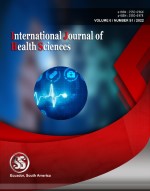Lamina papyracea position in patients with allergic nasal polypi
A computed tomography analysis
Keywords:
allergic rhinitis, nasal polyps, Endoscopic sinus surgery, Laminal papyracea, Orbital complicationsAbstract
Objective: This study aimed to describe the variations of the position of lamina papyracea (LP) in patients with allergic nasal polyposis candidate for functional endoscopic sinus surgery (FESS), by computed tomography (CT) analysis. Méthod: Paranasal CT scan of patients diagnosed to have allergic nasal polypi were included in this study and positions of lamina papyracea were registered then analyzed in relation to allergic sinonasal polypi grading. Results: fifty subjects (100 nasal sides) were included in the current study. Grade of nasal polypi was not necessarily associated with certain grade of lamina payracea. Conclusion: This study improves surgeons’ awareness of LP position in different grades of allergic sinonasal polypi and highlights that meticulous preoperative reading of every CT is the key to avoid LP injury during FESS.
Downloads
References
Soler ZM, Mace J, Smith TL. Symptom-based presentation of chronic rhinosinusitis and symptom-specific outcomes after endoscopic sinus surgery. Am J Rhinol. 2008;22(3):297–301.
Graham SM, Nerad JA. Orbital complications in endoscopic sinus surgery using powered instrumentation. Laryngoscope. 2003;113(5):874–8.
Krings JG, Kallogjeri D, Wineland A, Nepple KG, Piccirillo JF, Getz AE. Complications of Primary and Revision Functional Endoscopic Sinus Surgery for Chronic Rhinosinusitis. 2014;(April):838–45.
FA: Mohammed, R. A., Saifaddin, A. L., Mahmood, H. F., & Habibi, N. (2022). Seismic Performance of I-shaped Beam-column Joint with Cubical and Triangular Slit Dampers Based on Finite Element Analysis. Journal of Studies in Science and Engineering, 2(1), 17-31.
FA: Hersh F. Mahmood, Hooshang Dabbagh, Azad A. Mohammed, Comparative study on using chemical and natural admixtures (grape and mulberry extracts) for concrete, Case Studies in Construction Materials, Volume 15, 2021,
Kumar, S. (2022). A quest for sustainium (sustainability Premium): review of sustainable bonds. Academy of Accounting and Financial Studies Journal, Vol. 26, no.2, pp. 1-18
Allugunti, V.R. (2019). Diabetes Kaggle Dataset Adequacy Scrutiny using Factor Exploration and Correlation. International Journal of Recent Technology and Engineering, Volume-8, Issue-1S4, pp 1105-1110.
Meyers RM, Valvassori G. Interpretation of anatomic variations of computed tomography scans of the sinuses: A surgeon’s perspective. Laryngoscope. 1998;108(3):422–5.
Chong VFH, Fan YF, Lau D, Sethi DS. Functional endoscopic sinus surgery (FESS): What radiologists need to know. Clin Radiol. 1998;53(9):650–8.
Castro E, Seeley M, Kosmorsky G, Foster JA. Orbital compartment syndrome caused by intraorbital bacitracin ointment after endoscopic sinus surgery. Am J Ophthalmol. 2000;130(3):376–8.
Herzallah IR, Marglani OA, Shaikh AM. Variations of lamina papyracea position from the endoscopic view: A retrospective computed tomography analysis. Int Forum Allergy Rhinol. 2015;5(3):263–70.
Maharjan S. Nasal Polyposis: A Review. Glob J Otolaryngol. 2017;8(2):8–11.
Aouad RK, Chiu AG. State of the art treatment of nasal polyposis. Am J Rhinol Allergy. 2011;25(5):291–8.
Bhatti MT, Stankiewicz JA. Ophthalmic complications of endoscopic sinus surgery. Surv Ophthalmol. 2003;48(4):389–402.
El-anwar MW, Omar A, Bakry D. Lamina papyracea position in patients with nasal polypi : A computed tomography analysis Lamina papyracea position in patients with nasal polypi : A computed tomography analysis. Auris Nasus Larynx [Internet].2017;45(3):48791.
Passali D, Bernstein JM, Passali FM, Damiani V, Passali GC, Bellusi L. Treatment of recurrent chronic hyperplastic sinusitis with nasal poly- posis. Arch Otol Head Neck 2003;129:656–9.
Published
How to Cite
Issue
Section
Copyright (c) 2022 International journal of health sciences

This work is licensed under a Creative Commons Attribution-NonCommercial-NoDerivatives 4.0 International License.
Articles published in the International Journal of Health Sciences (IJHS) are available under Creative Commons Attribution Non-Commercial No Derivatives Licence (CC BY-NC-ND 4.0). Authors retain copyright in their work and grant IJHS right of first publication under CC BY-NC-ND 4.0. Users have the right to read, download, copy, distribute, print, search, or link to the full texts of articles in this journal, and to use them for any other lawful purpose.
Articles published in IJHS can be copied, communicated and shared in their published form for non-commercial purposes provided full attribution is given to the author and the journal. Authors are able to enter into separate, additional contractual arrangements for the non-exclusive distribution of the journal's published version of the work (e.g., post it to an institutional repository or publish it in a book), with an acknowledgment of its initial publication in this journal.
This copyright notice applies to articles published in IJHS volumes 4 onwards. Please read about the copyright notices for previous volumes under Journal History.
















